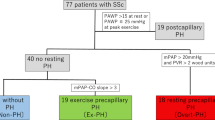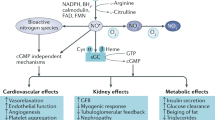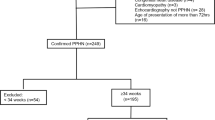Abstract
Nitric oxide (NO) plays a major role in cardiopulmonary regulation as illustrated by the alterations of the NO system described in cardiopulmonary illnesses. Recent studies have found an association between panic disorder and cardiovascular death and illness, as well as pulmonary diseases. Our objective was to investigate whether pulmonary or systemic NO production was altered during induced panic attacks (PAs). We used a double-blind placebo-controlled crossover design with randomization of the order of an injection of placebo and pentagastrin, a cholecystokinin-B receptor agonist that induces PAs in healthy volunteers (HVs). A total of 17 HVs experienced a PA after pentagastrin challenge. Exhaled NO and NO metabolites were measured by chemiluminescence. During pentagastrin-induced PAs, HVs displayed significant decreases in plateau concentrations of NO exhaled, which were associated with proportional increases in minute ventilation. There were no significant changes in pulmonary or systemic NO production. These results suggest that the decrease in exhaled NO concentration observed during pentagastrin-induced PAs is related to the associated hyperventilation, rather than to any change in lung NO production. This study is the first to evaluate changes in NO measurements during acute anxiety.
Similar content being viewed by others
Log in or create a free account to read this content
Gain free access to this article, as well as selected content from this journal and more on nature.com
or
References
Abelson JL, Weg JG, Nesse RM, Curtis GC (2001). Persistent respiratory irregularity in patients with panic disorder. Biol Psychiatry 49: 588–595.
American Psychiatric Association (1994). DSM-IV: Diagnostic and Statistical Manual of Mental Disorders. American Psychiatric Press: Washington, DC.
Amering M, Bankier B, Berger P, Griengl H, Windhaber J, Katschnig H (1999). Panic disorder and cigarette smoking behavior. Compr Psychiatry 140: 35–38.
Archer SL (1993). Measurement of nitric oxide in biological models. FASEB J 7: 349–360.
Archer SL, Djaballah K, Humbert M, Weir KE, Fartoukh M, Dall'ava-Santucci J et al (1998). Nitric Oxide deficiency in fenfluramine- and dexfenfluramine-induced pulmonary hypertension. Am J Respir Crit Care Med 158: 1061–1067.
Barnes PJ, Belvisi MG (1993). Nitric oxide and lung disease. Thorax 48: 1034–1043.
Bradwejn J, LeGrand J-M, Koszycki D, Bates JHT, Bourin M (1998). Effects of cholecystokinin tetrapeptide on respiratory function in healthy volunteers. Am J psychiatry 155: 280–282.
Bradwejn J, Koszycki D, Paradis M, Reece P, Hinton J, Sedman A (1995). Effect of CI-988 on cholecystokinin tetrapeptide-induced panic symptoms in healthy volunteers. Biol Psychiatry 38: 742–746.
Bradwejn J, Koszycki D, Shriqui C (1991). Enhanced sensitivity to cholecystokinin tetrapeptide in panic disorder; clinical and behavioral findings. Arch Gen Psychiatry 48: 603–610.
Cooke JP, Tsao PS (1994). Is NO an endogenous antiatherogenic molecule? Arteriosclet Thromb 14: 653–655.
Coryell W (1988). Panic disorder and mortality. Psychiatr Clin North Am 11: 433–440.
Coryell W, Noyes R, Clancy J (1982). Excess mortality in panic disorder. Arch Gen Psychiatry 39: 701–703.
Coryell W, Noyes R, Hause JD (1986). Mortality among outpatients with anxiety disorders. Am J Psychiatry 143: 508–510.
Dillon WC, Hampl V, Schultz PJ, Rubins JB, Archer SL (1996). Origins of breath nitric oxide in humans. Chest 110: 930–938.
Goetz RR, Klein DF, Kahn J, Liebowitz MR, Fyer AJ, Gorman JM (1993). Panic attacks during placebo procedures in the laboratory. Physiology and symptomatology. Arch Gen Psychiatry 50: 280–285.
Gorman JM, Goetz R, Martinez J, Uy J, Ross D, Fyer AJ et al (1988). Hyperventilation occurs during lactate-induced panic. J Anxiety Disord 2: 193–202.
Gorman JM, Kent J, Martinez J, Browne S, Coplan J, Papp LA (2001). Physiological changes during carbon dioxide inhalation in patients with panic disorder, major depression and premenstrual dysphoric syndrome. Arch Gen Psychiatry 58: 125–131.
Gustafsson LE, Leone AM, Person MG, Wiklund NP, Moncada S (1991). Endogenous nitric oxide is present in the exhaled air of rabbits, guinea pigs and humans. Biochem Biophys Res Commun 181: 852–857.
Hamid Q, Springall DR, Riveros-Moreno V (1997). Induction of nitric oxide synthase in asthma. J Allergy Clin Immunol 150: 624–629.
Jones B, Kenward MG (1989). Design and Analysis of Cross-Over Trials. Chapman & Hall: New York.
Kawachi I, Colditz GA, Ascherio A, Rimm EB, Giovanucci E, Stampfer MJ et al (1994). Prospective study of phobic anxiety and risk of coronary heart disease in men. Circulation 89: 1992–1997.
Kharitonov S, Alving K, Barnes PJ (1997). Exhaled and nasal nitric oxide measurements: recommendations. Eur Res J 10: 1683–1693.
Kharitonov S, Chung KF, Evans DJ, O'Connor BJ, Barnes PJ (1996). Increased exhaled nitric oxide in asthma is derived from the lower respiratory tract. Am J Respir Crit Care Med 153: 1773–1780.
Klein DF (1993). False suffocation alarms, spontaneous panic and related conditions: an integrative hypothesis. Arch Gen Psychiatry 50: 306–317.
Le Mellédo J-M, Bradwejn J, Koszycki D, Bichet DG, Bellavance F (1998). The role of the B-noradrenergic system in cholecystokinin-tetrapeptide-induced panic symptoms. Biol Psychiatry 44: 364–366.
Leone AM, Gustafsson LE, Francis PL, Persson MG, Wiklund NP, Moncada S (1994). Nitric oxide in exhaled breath in humans: direct GC-MS confirmation. Biochem Biophys Res Commun 201: 883–887.
Lydiard RB, Ballenger JC, Laraie MT, Fossey MD, Beinfeld MC (1992). CSF cholecystokinin concentrations in patients with panic disorder and normal comparison subjects. Am J Psychiatry 149: 691–693.
Mansour VM, Wilkinson DJC, Jennings GL, Schwarz RG, Thompson JM, Esler MD (1998). Panic disorder: coronary spasm as a basis for cardiac risk? Med J Aust 168: 390–392.
Mochizuki S, Toyota E, Hiramatsu O, Kajita T, Shigeto F, Takemoto M et al (2000). Effect of dietary control on plasma nitrate level and estimation of basal systemic nitric oxide production rate in humans. Heart Vessels 15: 274–279.
Moncada S, Palmer RMJ, Higgs EA (1991). Nitric oxide: physiology, pathophysiology and pharmacology. Pharmacol Rev 43: 109–143.
Phillips CR, Giraud GD, Holden WE (1996). Exhaled nitric oxide during exercise: site of release and modulation by ventilation and blood flow. J Appl Physiol 80: 1865–1871.
Riley MS, Pórszász J, Miranda J, Engelen MPKJ, Brundage B, Wasserman K (1997). Exhaled nitric oxide during exercise in primary pulmonary hypertension and pulmonary fibrosis. Chest 111: 44–50.
Rutgers SR, Meijer RJ, Kerstjens HAM, van der Mark ThW, Koëter GH, Postma DS (1998). Nitric oxide measured with single-breath and tidal-breathing methods in asthma and COPD. Eur Respir J 12: 816–819.
Shlik J, Vasar V, Aluoja A, Kingisepp P-H, Jagomägi K, Vasar E et al (1997). The effect of cholecystokinin tetrapeptide on respiratory resistance in healthy volunteers. Biol Psychiatry 42: 206–212.
Spinhoven P, Ros M, Westgeest A, Van der Does AJ (1994). The prevalence of respiratory disorders in panic disorder, major depressive disorder and V-code patients. Behav Res Ther 32: 647–649.
St. Croix CM, Wetter TJ, Pegelow DF, Meyer KC, Dempsey JA (1999). Assessment of nitric oxide formation during exercise. Am J Respir Crit Care Med 159: 1125–1133.
Van Megen HJGM, Westenberg HGM, den Boer JA, Haigh JRM, Traub M (1994). Pentagastrin induced panic attacks: enhanced sensitivity in panic disorder patients. Psychopharmacology 114: 449–455.
Van Megen HJGM, Westenberg HGM, den Boer JA, Kahn RS (1996). Cholecystokinin in anxiety. Eur Neuropsychopharmacol 6: 263–280.
Wang J, Brown MA, Tam SH, Chan MC, Whitworth JA (1997). Effects of diet on measurement of NO metabolites. Clin Exp Pharmacol Physiol 24: 418–420.
Weissman MM, Markowitz JS, Oulette R, Greenwald S, Kahan JP (1990). Panic disorder and cardiovascular/cerebrovascular problems: results from a community survey. Am J Psychiatry 147: 1504–1508.
Yeragani VK, Sobolewski E, Igel G, Johnson C, Jampala VC, Kay J et al (1998). Decreased heart-period variability in patients with panic disorder: a study of Holter ECG records. Psychiatry Res 78: 89–99.
Zapol WM, Rimar S, Gillis N (1994). Nitric oxide and the lung. Summary of an NHLBI workshop. Am J Respir Crit Care Med 149: 1375–1380.
Acknowledgements
We thank Janisse Khudabux RN, Tom Ryan, Ross Waite, and Kyoko Hashimoto for their collaboration in the development and execution of the study. Also, we would like to thank Gustavo Carrero MSc for mathematical assistance and advice. This research was sponsored by an operating grant of the University of Alberta Hospital Foundation to JMLM and SA as well as by a Canadian Institute of Health Research (CIHR) grant to JMLM. JMLM is an AHFMR (Alberta Heritage Foundation For Medical Research) clinical investigator. SA is an AHFMR scientist, supported by the Heart and Stroke Foundation of Alberta.
Author information
Authors and Affiliations
Corresponding author
Rights and permissions
About this article
Cite this article
Lara, N., Chrapko, W., Archer, S. et al. Pulmonary and Systemic Nitric Oxide Measurements During CCK-5-Induced Panic Attacks. Neuropsychopharmacol 28, 1840–1845 (2003). https://doi.org/10.1038/sj.npp.1300241
Received:
Revised:
Accepted:
Published:
Issue date:
DOI: https://doi.org/10.1038/sj.npp.1300241



